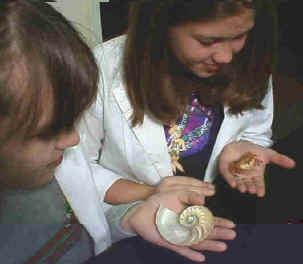 Philosophy
Secondary
Philosophy
Secondary  Philosophy
Secondary
Philosophy
Secondary
The secondary curriculum was developed after it was realized that children from elementary schools with our program were not challenged in junior high school with the existing science curriculum. This trend was noticed about 3 years after our initial elementary school implementation.
 A grant from the Packard Foundation in East
Palo Alto, California to the Ravenswood School District provided funds to
construct science laboratories and science equipment. In the other pilot
school districts we found a similar problem as our elementary students went on
to junior high. The most noted comment was that students from schools with
our program understood how to use hands-on material in a lab situation and kept
detailed notes on experiments. Many of the teachers remarked that the
students said that they had done that experiment already.
A grant from the Packard Foundation in East
Palo Alto, California to the Ravenswood School District provided funds to
construct science laboratories and science equipment. In the other pilot
school districts we found a similar problem as our elementary students went on
to junior high. The most noted comment was that students from schools with
our program understood how to use hands-on material in a lab situation and kept
detailed notes on experiments. Many of the teachers remarked that the
students said that they had done that experiment already.
We also realized that students who did not participate in the I. Science MaTe program were at a disadvantage. The challenge was to develop a program that could act as a new experience and as a review. The creation of the curriculum is still being created as we use digital technology to make the program a multimedia delight to students and teachers.
As our materials became accessible we realized that many high school teachers were using the materials to introduce subjects to their students. Students still can go through an educational system without the content of science. So in 2001 as we were created the materials for the internet we decided to create electronic textbooks for the students. We also started to develop slideshows for the teacher that would bring the students to a common level. The I. Science MaTe Secondary Reference Curriculum is not meant as an Advanced Placement, but as a baseline knowledge grid. The material reviews most the content in the I. Science MaTe Elementary, but goes into each of the content areas in more detail.
As we were piloting the materials in the 1980's we tried to integrate the content as we did in the elementary curriculum. However, this became difficult for several reasons. Most standards are still in the basic content areas: Physical, Biological, and Earth Sciences. Different school districts in junior high and high school are very flexible with the content. The teacher has ultimate control, and the quality of the science program is dependant on them individually.
So the materials that appear are lesson plans that go through the basic content quickly. The hands-on experience varies from 1-3 laboratory experiences per week. The teacher can choose the units and then decide how to use them.